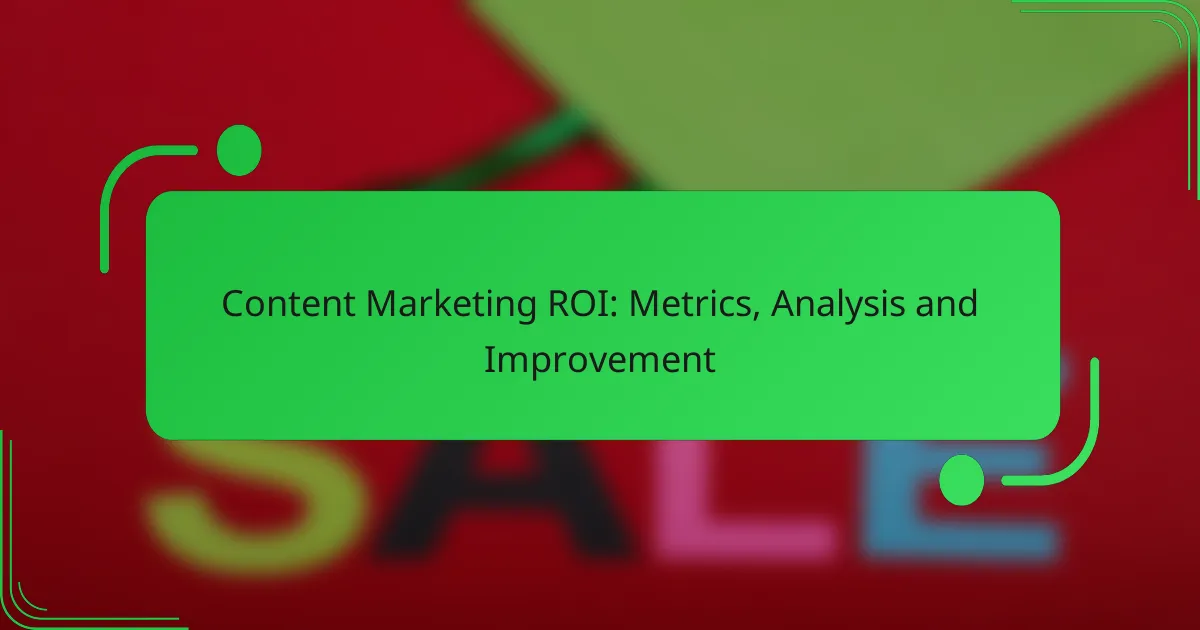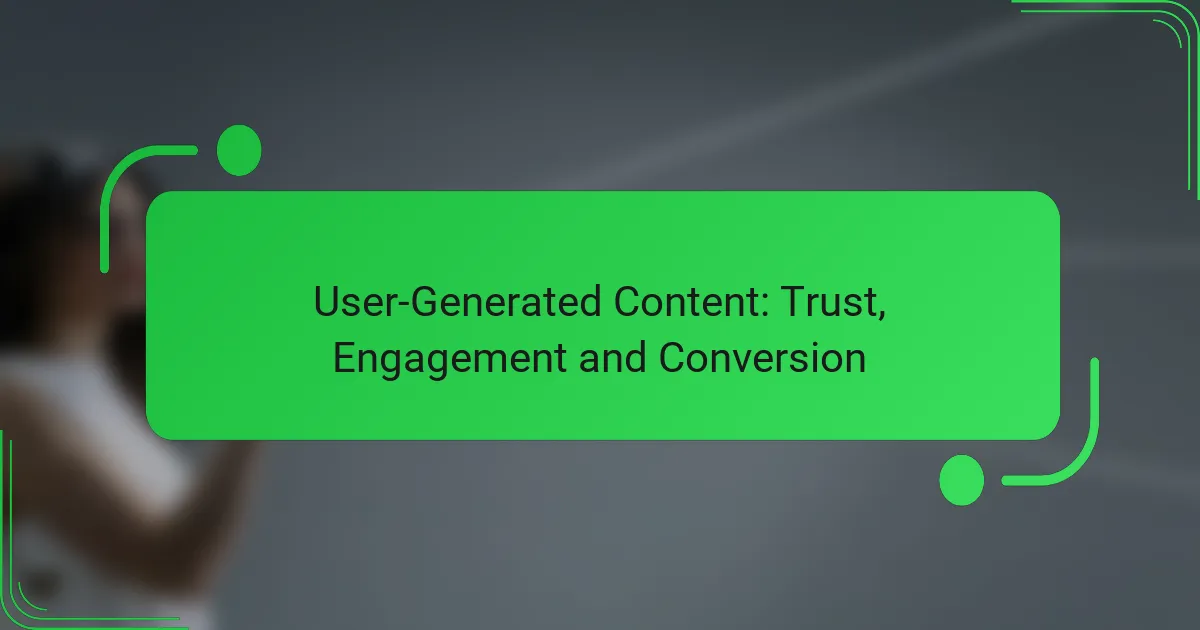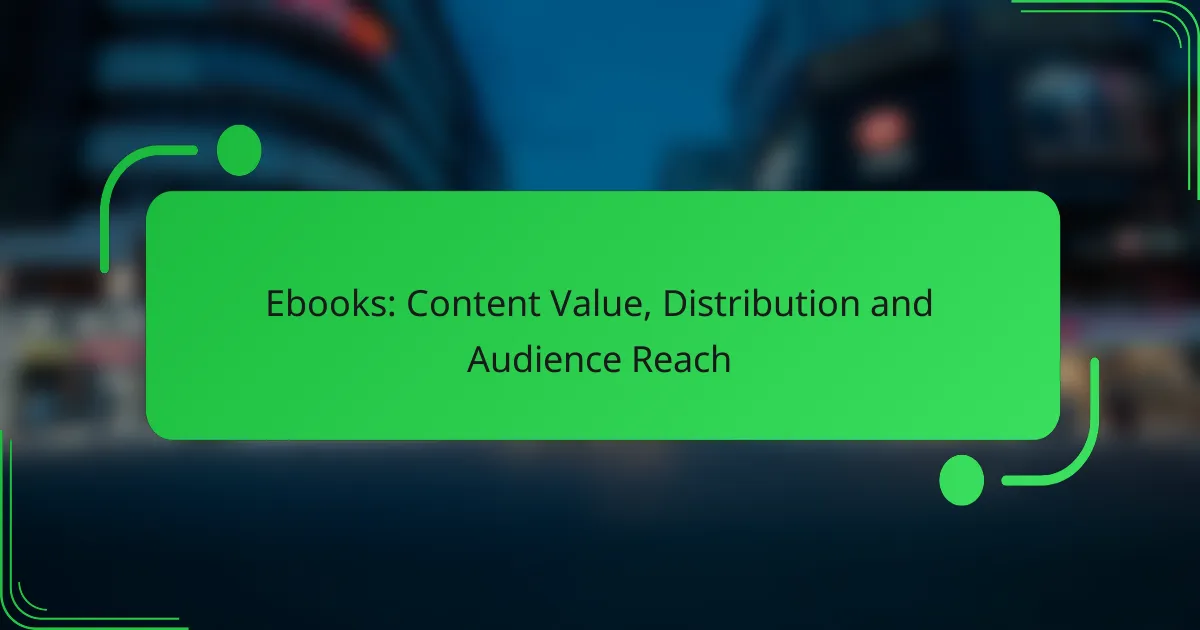Understanding and measuring content marketing ROI is crucial for businesses aiming to maximize their marketing investments. By analyzing key metrics such as website traffic, conversion rates, and customer engagement, companies can gain valuable insights into the effectiveness of their content strategies. Continuous improvement through data-driven adjustments can significantly enhance returns, ensuring that content efforts align with overall business goals.
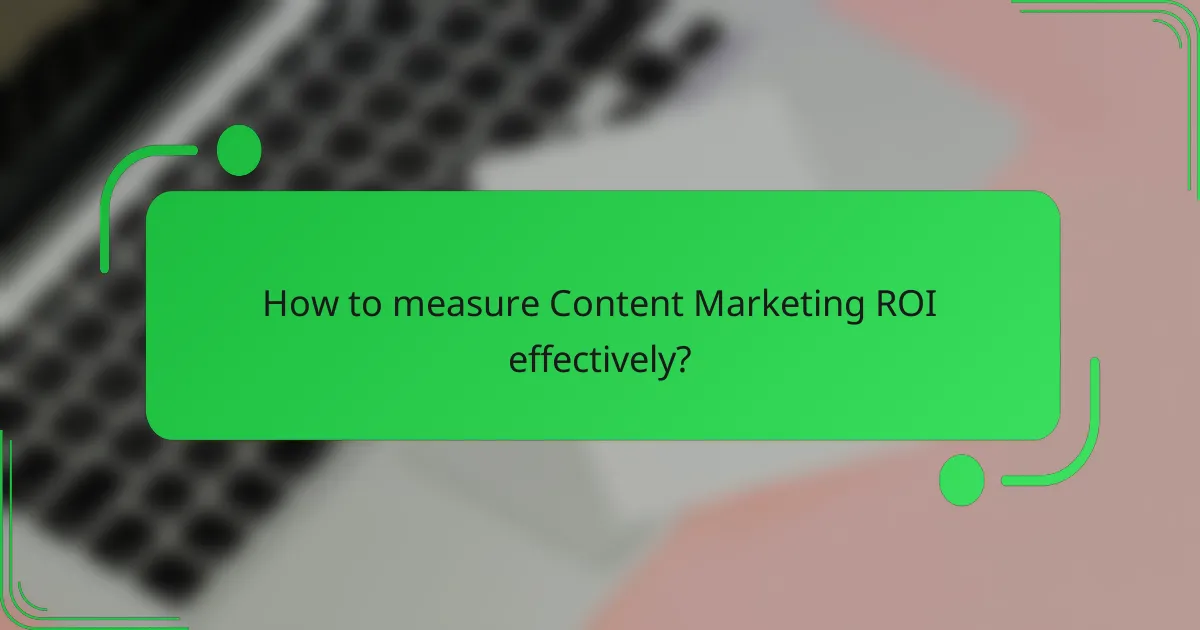
How to measure Content Marketing ROI effectively?
To measure content marketing ROI effectively, focus on tracking the financial returns generated from your content efforts against the costs incurred. This involves analyzing key metrics that reflect both direct revenue and the impact on customer engagement and retention.
Key performance indicators (KPIs)
Key performance indicators (KPIs) are essential metrics that help assess the effectiveness of your content marketing strategy. Common KPIs include website traffic, conversion rates, social media engagement, and lead generation. By monitoring these indicators, you can gain insights into how well your content is performing and where improvements are needed.
For instance, if your goal is to increase brand awareness, track metrics like page views and social shares. If you’re focused on sales, prioritize conversion rates and lead quality. Regularly reviewing these KPIs will help you adjust your strategy to maximize ROI.
Cost per acquisition (CPA)
Cost per acquisition (CPA) measures the total cost of acquiring a new customer through your content marketing efforts. This includes all expenses related to content creation, distribution, and promotion divided by the number of new customers gained. Understanding CPA helps you evaluate the efficiency of your marketing spend.
For example, if you spend $1,000 on a content campaign and acquire 50 new customers, your CPA would be $20. Keeping CPA low while maintaining quality leads is crucial for improving overall ROI. Aim for a CPA that aligns with your business model and customer lifetime value.
Customer lifetime value (CLV)
Customer lifetime value (CLV) estimates the total revenue a business can expect from a single customer over their entire relationship. This metric is vital for understanding the long-term value of your content marketing efforts. A higher CLV indicates that your content is effectively engaging and retaining customers.
To calculate CLV, consider average purchase value, purchase frequency, and customer lifespan. For example, if a customer spends $100 per purchase, buys twice a year, and stays for five years, their CLV would be $1,000. Knowing CLV helps you determine how much you can invest in acquiring new customers while still achieving a positive ROI.
Return on investment (ROI) formula
The return on investment (ROI) formula is a straightforward way to assess the profitability of your content marketing efforts. The basic formula is: (Net Profit / Cost of Investment) x 100. This calculation allows you to express ROI as a percentage, making it easier to compare different campaigns.
For example, if your content marketing generates $5,000 in revenue and costs $1,000, your net profit is $4,000. Plugging this into the formula gives you an ROI of 400%. Regularly calculating ROI helps you identify successful strategies and areas needing improvement, ensuring your content marketing remains a valuable investment.

What metrics are essential for analyzing Content Marketing ROI?
To effectively analyze Content Marketing ROI, focus on metrics that directly reflect the performance and impact of your content. Key metrics include website traffic, conversion rates, engagement metrics, and lead generation statistics, each providing insights into different aspects of your content’s effectiveness.
Website traffic analytics
Website traffic analytics measure the number of visitors to your site and how they interact with your content. Tools like Google Analytics can help track unique visitors, page views, and session duration, giving you a clear picture of content performance. Aim for consistent growth in traffic over time, as this indicates effective content strategies.
Consider segmenting traffic sources to understand where your audience is coming from, whether organic search, social media, or referrals. This can help you allocate resources effectively and optimize your content distribution channels.
Conversion rates
Conversion rates indicate the percentage of visitors who take a desired action, such as signing up for a newsletter or making a purchase. A higher conversion rate suggests that your content effectively persuades visitors to engage further with your brand. Track conversions using tools like Google Tag Manager to set up goals and monitor performance.
To improve conversion rates, focus on optimizing calls-to-action (CTAs) and ensuring that your content aligns with user intent. A/B testing different CTAs can provide insights into what resonates best with your audience.
Engagement metrics
Engagement metrics assess how users interact with your content, including time spent on page, bounce rate, and social shares. High engagement levels often correlate with content quality and relevance, indicating that your audience finds value in what you offer. Use analytics tools to track these metrics and identify trends over time.
Encourage engagement by creating interactive content, such as quizzes or polls, and by promoting user-generated content. This can enhance community involvement and increase the likelihood of shares and repeat visits.
Lead generation statistics
Lead generation statistics measure the effectiveness of your content in attracting potential customers. This includes tracking the number of leads generated through forms, downloads, or subscriptions. A robust lead generation strategy often relies on high-quality content that addresses the needs and pain points of your target audience.
To optimize lead generation, ensure that your content includes clear, compelling offers and easy-to-navigate forms. Regularly review your lead sources to identify which content types yield the best results, allowing you to refine your approach accordingly.

How to improve Content Marketing ROI?
Improving Content Marketing ROI involves optimizing your content strategies, refining your target audience, and leveraging data-driven insights. By focusing on these areas, you can enhance engagement and conversion rates, ultimately leading to better returns on your marketing investments.
Content optimization strategies
Content optimization strategies focus on enhancing the quality and relevance of your content to attract and retain your audience. This includes using SEO best practices, such as keyword research and on-page optimization, to ensure your content ranks well in search engines.
Additionally, consider updating existing content to keep it fresh and relevant. Regularly analyzing performance metrics can help identify which pieces of content drive the most engagement and conversions, allowing you to allocate resources effectively.
Target audience refinement
Refining your target audience is crucial for maximizing Content Marketing ROI. Start by creating detailed buyer personas that represent your ideal customers, including demographics, interests, and pain points. This helps tailor your content to meet their specific needs.
Utilize analytics tools to gather data on your audience’s behavior and preferences. This information can guide your content creation process, ensuring that you address the right topics and use the appropriate tone and style to resonate with your audience.
Utilizing A/B testing
A/B testing allows you to compare two versions of content to determine which performs better in terms of engagement and conversion. This method can be applied to headlines, calls to action, and even content formats to identify what resonates most with your audience.
When conducting A/B tests, ensure you have a clear hypothesis and measurable goals. Analyze the results to make informed decisions about future content strategies, and be prepared to iterate based on what the data reveals.
Leveraging social media platforms
Leveraging social media platforms is essential for amplifying your content reach and engagement. Each platform has its unique audience and content preferences, so tailor your messaging accordingly. For instance, visual content performs well on Instagram, while informative articles may thrive on LinkedIn.
Engagement on social media can significantly impact your Content Marketing ROI. Encourage interactions through comments, shares, and likes, and consider using paid advertising to boost visibility for high-performing content. Regularly analyze social media metrics to refine your approach and maximize effectiveness.
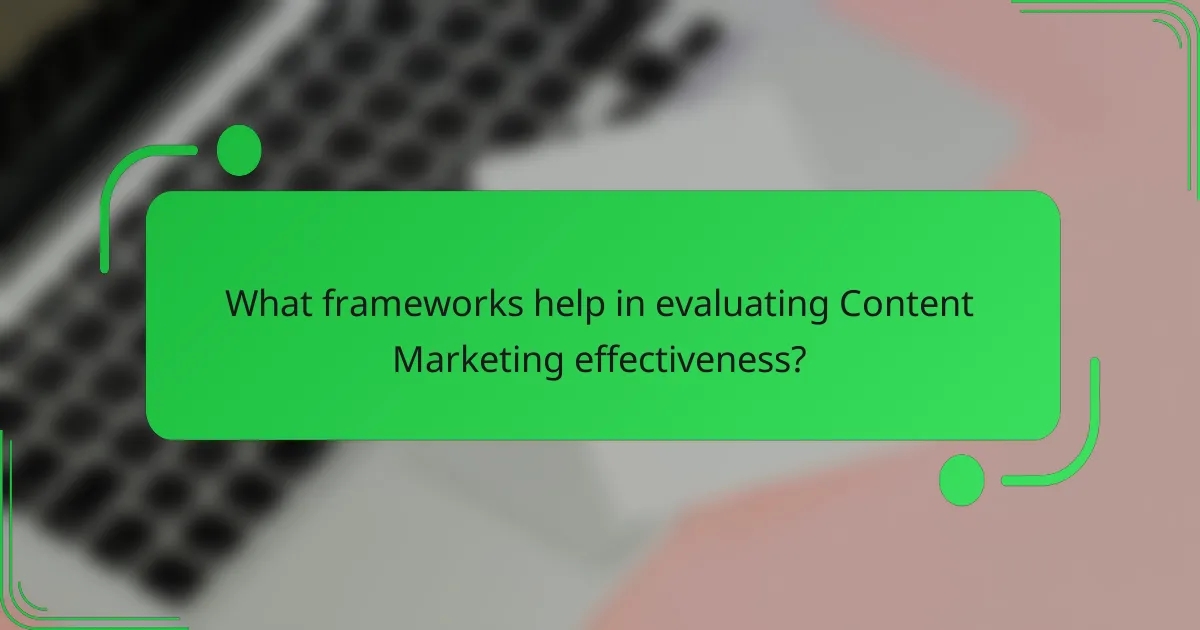
What frameworks help in evaluating Content Marketing effectiveness?
To evaluate content marketing effectiveness, several frameworks can be utilized, including funnel analysis and attribution models. These frameworks help marketers understand how content influences customer behavior and the overall return on investment.
Content marketing funnel analysis
Content marketing funnel analysis examines how content engages potential customers at various stages of their buying journey. This framework typically divides the funnel into stages: awareness, consideration, and decision. By analyzing performance metrics at each stage, marketers can identify where content is succeeding or failing.
For instance, if a blog post generates high traffic but low conversion rates, it may indicate that while the content attracts attention, it fails to persuade readers to take the next step. Marketers should focus on optimizing content for each funnel stage, ensuring it aligns with the audience’s needs and expectations.
Attribution models
Attribution models assign credit to different marketing channels based on their contribution to conversions. Common models include first-click, last-click, and multi-touch attribution. Each model offers a unique perspective on how content interacts with other marketing efforts.
For example, a last-click model attributes all credit to the final touchpoint before conversion, which may undervalue earlier content that influenced the decision. Marketers should consider using multi-touch attribution to gain a comprehensive view of how various content pieces work together to drive conversions.
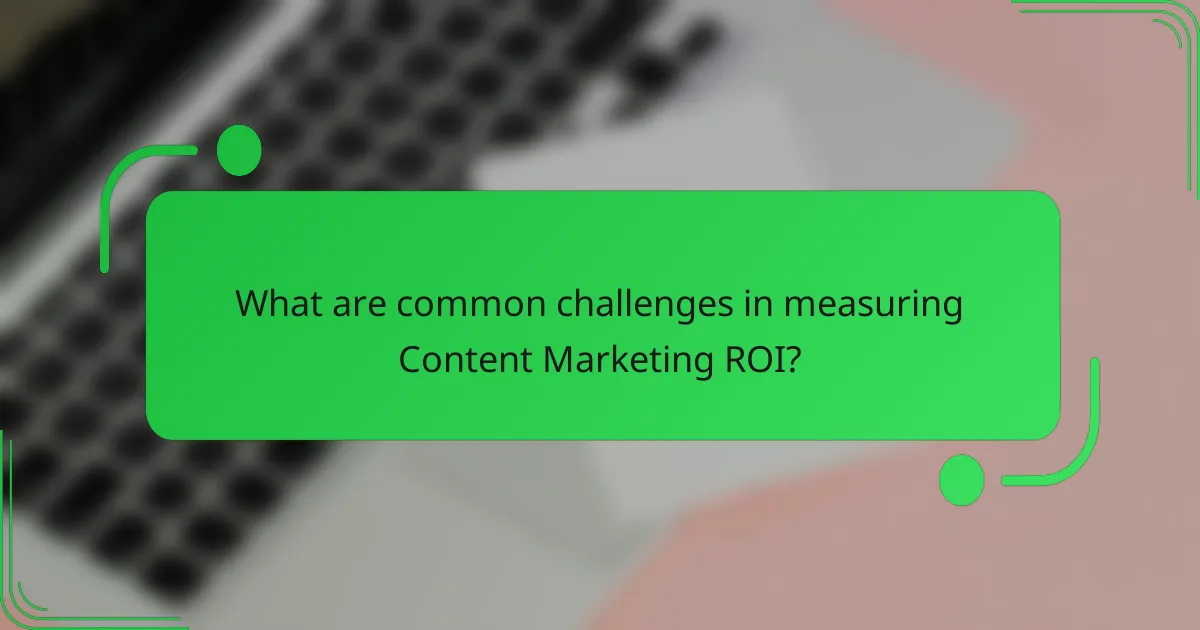
What are common challenges in measuring Content Marketing ROI?
Measuring Content Marketing ROI can be complex due to various challenges that marketers face. Key issues include data collection difficulties, attributing revenue to specific content, and the long-term nature of content marketing results.
Data collection issues
Data collection issues often arise from the fragmented nature of digital marketing tools and platforms. Marketers may struggle to gather consistent data across different channels, leading to incomplete insights about content performance.
To mitigate these challenges, it’s essential to use integrated analytics tools that can consolidate data from various sources. For instance, using platforms like Google Analytics alongside social media insights can provide a more comprehensive view of content effectiveness.
Additionally, ensure that tracking mechanisms, such as UTM parameters, are consistently applied across all content. This practice helps in accurately attributing traffic and conversions to specific marketing efforts, enhancing the reliability of ROI calculations.
